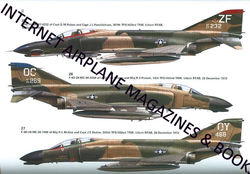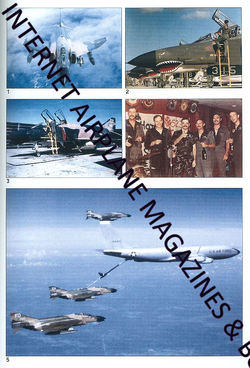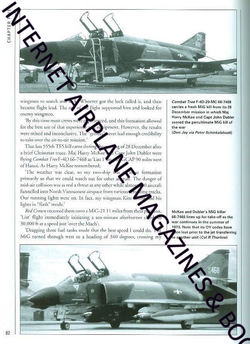----------------------------------------------------------------------------------------------------------------
Additional Information from Internet Encyclopedia
n USAF service, the F-4 was initially designated
the F-110 Spectre[53] prior to the introduction of the 1962 United States
Tri-Service aircraft designation system. The USAF quickly embraced the design
and became the largest Phantom user. The first USAF Phantoms in Vietnam were
F-4Cs from the 43rd Tactical Fighter Squadron arrived in December 1964.
Unlike the U.S. Navy and U.S. Marine Corps, which
flew the Phantom with a Naval Aviator (pilot) in the front seat and a Naval
Flight Officer as a radar intercept officer (RIO) in the back seat, the USAF
initially flew its Phantoms with a rated Air Force Pilot in front and back
seats. While the rear pilot (GIB, or "guy in back") could fly and
ostensibly land the aircraft, he had fewer flight instruments and a very
restricted forward view. The Air Force later assigned a rated Air Force
Navigator qualified as a weapon/targeting systems officer (later designated as
weapon systems officer or WSO) in the rear seat instead of another pilot.
On 10 July 1965, F-4Cs of the 45th Tactical
Fighter Squadron, 15th TFW, on temporary assignment in Ubon, Thailand,[56]
scored the USAF's first victories against North Vietnamese MiG-17s using AIM-9
Sidewinder air-to-air missiles.[57] On 26 April 1966, an F-4C from the 480th
Tactical Fighter Squadron scored the first aerial victory by a U.S. aircrew
over a North Vietnamese MiG-21 "Fishbed".[58] On 24 July 1965,
another Phantom from the 45th Tactical Fighter Squadron became the first
American aircraft to be downed by an enemy SAM, and on 5 October 1966 an 8th
Tactical Fighter Wing F-4C became the first U.S. jet lost to an air-to-air
missile, fired by a MiG-21.
Early aircraft suffered from leaks in wing fuel
tanks that required re-sealing after each flight and 85 aircraft were found to
have cracks in outer wing ribs and stringers.[52] There were also problems with
aileron control cylinders, electrical connectors, and engine compartment fires.
Reconnaissance RF-4Cs made their debut in Vietnam on 30 October 1965, flying
the hazardous post-strike reconnaissance missions. The USAF Thunderbirds used
the F-4E from the 1969 season until 1974.
Although the F-4C was essentially identical to the
Navy/Marine Corps F-4B in flight performance and carried the AIM-9 Sidewinder
missiles, USAF-tailored F-4Ds initially arrived in June 1967 equipped with
AIM-4 Falcons. However, the Falcon, like its predecessors, was designed to
shoot down heavy bombers flying straight and level. Its reliability proved no
better than others and its complex firing sequence and limited seeker-head
cooling time made it virtually useless in combat against agile fighters. The
F-4Ds reverted to using Sidewinders under the "Rivet Haste" program
in early 1968, and by 1972 the AIM-7E-2 "Dogfight Sparrow" had become
the preferred missile for USAF pilots. Like other Vietnam War Phantoms, the
F-4Ds were urgently fitted with radar warning receivers to detect the
Soviet-built S-75 Dvina SAMs.
From the initial deployment of the F-4C to
Southeast Asia, USAF Phantoms performed both air superiority and ground attack
roles, supporting not only ground troops in South Vietnam, but also conducting
bombing sorties in Laos and North Vietnam. As the F-105 force underwent severe
attrition between 1965 and 1968, the bombing role of the F-4 proportionately
increased until after November 1970 (when the last F-105D was withdrawn from
combat) it became the primary USAF tactical ordnance delivery system. In
October 1972 the first squadron of EF-4C Wild Weasel aircraft deployed to
Thailand on temporary duty. The "E" prefix was later dropped and the
aircraft was simply known as the F-4C Wild Weasel.
USAF F-4 Phantom II destroyed on 18 February 1968,
during the enemy attack against Tan Son Nhut, during the Tet Offensive
Sixteen squadrons of Phantoms were permanently
deployed between 1965 and 1973, and 17 others deployed on temporary combat
assignments.[61] Peak numbers of combat F-4s occurred in 1972, when 353 were
based in Thailand.[62] A total of 445 Air Force Phantom fighter-bombers were
lost, 370 in combat and 193 of those over North Vietnam (33 to MiGs, 30 to
SAMs, and 307 to AAA).[62]
The RF-4C was operated by four squadrons,[63] and
of the 83 losses, 72 were in combat including 38 over North Vietnam (seven to
SAMs and 65 to AAA).[62] By war's end, the U.S. Air Force had lost a total of
528 F-4 and RF-4C Phantoms. When combined with U.S. Navy and Marine Corps
losses of 233 Phantoms, 761 F-4/RF-4 Phantoms were lost in the Vietnam War.
On 28 August 1972, Captain Steve Ritchie became
the first USAF ace of the war.[6] On 9 September 1972, WSO Capt Charles B.
DeBellevue became the highest-scoring American ace of the war with six
victories.[6] and WSO Capt Jeffrey Feinstein became the last USAF ace of the
war on 13 October 1972.[65] Upon return to the United States, DeBellevue and
Feinstein were assigned to undergraduate pilot training (Feinstein was given a
vision waiver) and requalified as USAF pilots in the F-4. USAF F-4C/D/E crews
claimed 107� MiG kills in Southeast Asia (50 by Sparrow, 31 by Sidewinder, five
by Falcon, 15.5 by gun, and six by other means).
On 31 January 1972, the 170th Tactical Fighter
Squadron/183d Tactical Fighter Group of the Illinois Air National Guard became
the first Air National Guard unit to transition to Phantoms from Republic F-84F
Thunderstreaks which were found to have corrosion problems.[66] Phantoms would
eventually equip numerous tactical fighter and tactical reconnaissance units in
the USAF active, National Guard, and reserve.
On 2 June 1972, a Phantom flying at supersonic
speed shot down a MiG-19 over Thud Ridge in Vietnam for the first supersonic
gun kill. At a recorded speed of Mach 1.2, Major Phil Handley's shoot down was
the first and only recorded gun kill while flying at supersonic speeds.
On 15 August 1990, 24 F-4G Wild Weasel Vs and six
RF-4Cs were deployed to Shaikh Isa AB, Bahrain, for Operation Desert Storm. The
F-4G was the only aircraft in the USAF inventory equipped for the Suppression
of Enemy Air Defenses (SEAD) role, and was needed to protect coalition aircraft
from Iraq's extensive air defense system. The RF-4C was the only aircraft
equipped with the ultra-long-range KS-127 LOROP (long-range oblique
photography) camera, and was used for a variety of reconnaissance missions. In
spite of flying almost daily missions, only one RF-4C was lost in a fatal
accident before the start of hostilities. One F-4G was lost when enemy fire
damaged the fuel tanks and the aircraft ran out of fuel near a friendly
airbase. The last USAF Phantoms, F-4G Wild Weasel Vs from 561st Fighter
Squadron, were retired on 26 March 1996. The last operational flight of the
F-4G Wild Weasel was from the 190th Fighter Squadron, Idaho Air National Guard,
in April 1996.[69] The last operational USAF/ANG F-4 to land was flown by Maj
Mike Webb and Maj Gary Leeder of the Idaho ANG.
Like the Navy, the Air Force has operated QF-4
target drones, serving with the 82d Aerial Targets Squadron at Tyndall Air
Force Base, Florida, and Holloman Air Force Base, New Mexico.[70] It was
expected that the F-4 would remain in the target role with the 82d ATRS until
at least 2015, when they would be replaced by early versions of the F-16
Fighting Falcon converted to a QF-16 configuration.[71] Several QF-4s also
retain capability as manned aircraft and are maintained in historical color
schemes, being displayed as part of Air Combat Command's Heritage Flight at air
shows, base open houses, and other events while serving as non-expendable
target aircraft during the week.[72] On 19 November 2013, BAE Systems delivered
the last QF-4 aerial target to the Air Force. The example had been in storage
for over 20 years before being converted. Over 16 years, BAE had converted 314
F-4 and RF-4 Phantom IIs into QF-4s and QRF-4s, with each aircraft taking six
months to adapt. As of December 2013, QF-4 and QRF-4 aircraft had flown over
16,000 manned and 600 unmanned training sorties, with 250 unmanned aircraft
being shot down in firing exercises. The remaining QF-4s and QRF-4s held their
training role until the first of 126 QF-16s were delivered by Boeing.[73] The
final flight of an Air Force QF-4 from Tyndall AFB took place on 27 May 2015 to
Holloman AFB.[74] After Tyndall AFB ceased operations, the 53d Weapons
Evaluation Group at Holloman became the fleet of 22 QF-4s' last remaining
operator. The base continued using them to fly manned test and unmanned live
fire test support and Foreign Military Sales testing, with the final unmanned
flight taking place in August 2016.[75] The type was officially retired from US
military service with a four�ship flight at Holloman during an event on 21
December 2016.[76] The remaining QF-4s were to be demilitarized after 1 January
2017.








